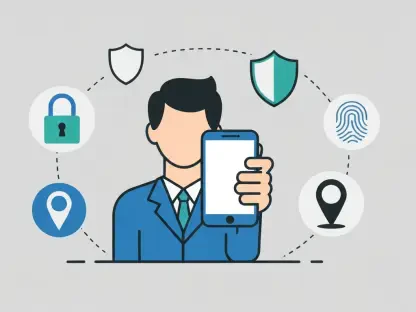Biometric technology, which leverages unique physical characteristics like fingerprints and facial features to access devices, has surged in popularity due to its undeniable convenience. Locking phones, tablets, and laptops merely by glancing at them or touching a sensor offers a faster and often more secure alternative to traditional passwords or PIN codes. However, this convenience comes with considerable privacy concerns, particularly in scenarios involving law enforcement. Recently, these issues have been thrust into the spotlight following a California court ruling, which underscores the legal ambiguities surrounding the use of biometric unlocking methods.
The Rise of Biometric Technology
Biometric unlocking methods have emerged as an efficient and user-friendly way to secure mobile devices. By relying on fingerprints or facial features, users can quickly and effortlessly unlock their phones, tablets, and laptops, often without even touching a button. This technology quickly gained traction as an alternative to passwords or PIN codes, which require users to remember often complicated sequences of characters. By comparison, unlocking a device with a simple touch or a glance is much more straightforward.
Yet, while biometric security features are seen as more secure than traditional methods, they are not without their controversies. The primary concern hinges on potential privacy violations, particularly when law enforcement and other governmental bodies get involved. Unlike a password or PIN code, biometric features do not require cognitive participation, which means they can be accessed without the device owner’s active input. This unique aspect raises significant questions about the protection of personal data, especially in legal contexts where authorities might exploit these security features.
Legal Precedents and Privacy Concerns
The legal landscape surrounding biometric technology was recently highlighted by the case of United States v. Jeremy Travis Payne. Following a drug raid, the California Highway Patrol used Payne’s fingerprint to unlock his phone. A court later ruled that this action did not violate Payne’s Fifth Amendment rights against self-incrimination nor his Fourth Amendment rights against unlawful searches and seizures. The reasoning was that the police did not employ coercion that necessitated mental effort or recall, thus sidestepping the protections afforded by the Fifth Amendment.
This ruling illuminated a critical distinction in the legal understanding of biometric data in contrast to memorized information. While a password or PIN requires the suspect’s cognitive effort to recall, biometric data can be obtained passively, much like collecting fingerprints or blood samples upon an arrest. However, this decision did not establish a universal precedent. It instead underscored the ongoing legal ambiguities and challenges faced when aligning biometric technology with existing constitutional protections.
Given the case’s specificity, it sparked a broader conversation about the evolving interpretations of privacy and self-incrimination in an age where technology and law increasingly intersect. Legal experts pointed out that while the ruling addressed Payne’s circumstances, broader questions remained unexamined—particularly whether forcing biometric data to unlock devices equates to compelled testimony, an area the Supreme Court has yet to comprehensively address.
Implications for Activists and Protestors
The legal interpretations of biometric unlocking methods have profound implications, especially for individuals who frequently engage with law enforcement, such as activists and protestors. Historical instances, such as mass arrests during protests against Israel’s treatment of Palestinians, have shown that authorities can use seized phones to extract sensitive personal information. In such contexts, the convenience of biometric security may unwittingly become a vulnerability.
The Electronic Frontier Foundation (EFF), a leading digital rights organization, has been vocal in advising protestors to disable facial and fingerprint recognition before attending demonstrations. The rationale is clear: while law enforcement can legally compel individuals to unlock their devices using biometric data, entering a PIN code requires cognitive effort, which the Fifth Amendment protects against. This advice serves as a preventive measure to safeguard personal privacy amidst potential overreach by authorities during protests and similar activities.
Practical Considerations and Legal Acceptance
From a practical standpoint, legal scholars such as criminal law professor Adam M. Gershowitz emphasize the practicality and widespread acceptance of biometric security over traditional methods like PINs or passwords. These insights underscore an increasing necessity for clear guidelines and protective laws that mirror the technological advancements in mobile security and the practical realities of modern life. However, the adoption of biometric unlocking methods must be tempered with appropriate safeguards to prevent misuse.
Civil liberties and privacy advocates continually recommend precautionary measures to guard against governmental overreach. The prevailing consensus favors disabling biometric features in situations where interaction with law enforcement is likely, thus offering better protection for personal data. While biometrics present undeniable convenience, they also expose users to potential privacy risks, particularly from unauthorized or compelled access by authorities.
Balancing Convenience and Privacy
Biometric technology, which uses distinctive physical traits like fingerprints and facial features, has become increasingly popular due to its undeniable convenience. Unlocking devices such as phones, tablets, and laptops by merely touching a sensor or glancing at the screen provides a faster and often more secure alternative to traditional passwords or PIN codes. This eases the user experience significantly. However, the rise of this technology brings considerable privacy concerns, especially when it comes to law enforcement situations. Recently, these concerns have been brought into sharper focus following a pivotal California court ruling. This ruling highlights the legal gray areas surrounding the use of biometric unlocking methods and raises questions about how such data might be accessed or used by authorities. As the legal system grapples with these issues, the tech industry and privacy advocates are closely monitoring developments to ensure that convenience does not come at the expense of user privacy.









